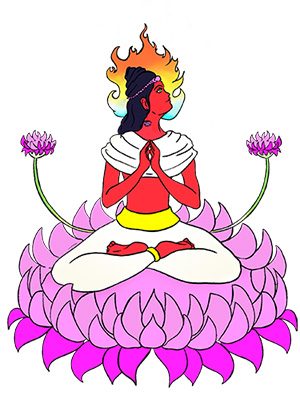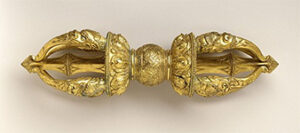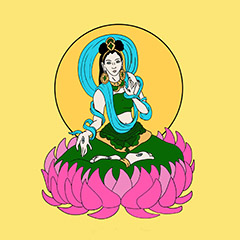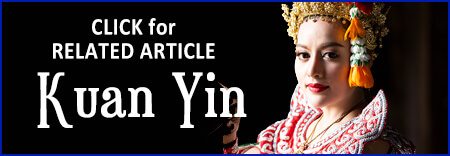
Five Female Buddha Mantras and Stories
The female buddhas are generally less well known than their male counterparts. However, the masculine buddhas all have feminine consorts with their own characteristics and mantras. When taken together, the masculine and feminine forms are a balanced whole.
Share this page with a friend!
Role of Deities in Buddhism
Buddhist deities are viewed as aspects of one God rather than separate beings. They are used to help the seeker visualize, concentrate on and internalize a specific aspect of God. In addition to the female Buddhas, the mother of Siddhartha Gautama is also revered, much like the Virgin Mary or Mother Mary in Catholicism.
Five Female Dhyani Buddhas
This article includes the five female buddhas associated with the Five Dhyani buddhas: Pandavarasini (counterpart of Amitabha), Locana (counterpart of Akshobhya), Mamaki (counterpart of Ratnasanbhava), Tara (counterpart of Amoghasiddhi) and Akasadhatesvari (counterpart of Vairocana).
Female Buddha Pandaravasini
Pandaravasini is the consort of Amitabha, one of the Five Dhyani Buddhas. The five Dhyani Buddhas are said to have existed since the beginning of time. They represent or symbolize divine principles or forces. They are self-born. The word dhyani is derived from the Sanskrit dhyana meaning “meditation.” The Dhyani Buddhas are also called Jinas, meaning Victors or Conquerors.
To learn more about the symbols and legends of Pandaravasini and hear her mantra, visit the page Pandaravasini: Amitabha Consort.
Characteristics of Pandavarasini
Color: Red
Element: Fire
Symbol: Lotus
Direction: West
Mudra: Devotion
Seed Syllable: PAM
Overcomes: Craving
Function: Attracting
Wisdom: Discrimination
Consort: Amitabha
Animal: Phoenix
Name: White-Robed One
NOTE: My resource for the female Buddha characteristics in this article and a treasure trove for more information is the book The Five Female Buddhas by Vessantra (Tony McMahon). Vessantra is also the author of Female Deities in Buddhism.
Female Buddha Locana: Mirror-Like Wisdom
Locana (sometimes spelled Lochana) is a female Buddha who is the feminine counterpart of Akshobya, one of the five Dhyani Buddhas. Her name means “The One with the Eye,” or the “Clear Visioned One.” She is associated with pure awareness, she represents the pure, simple, direct awareness of things as they are. Lochana is associated with a pale blue color.

Mantra for a Female Buddha: Lochana
Locana’s mantra is “Om Vajra Locana Lom Svaha.” Lochana’s left hand is in the dhyani mudra and holds a vajra-bell. Her right hand is in the bhumisparsa mudra and holds a five-pointed vajra. Vajra means a thunderbolt or mystical weapon. Lom is the seed syllable for Locana. Seed syllables are the fundamental essence of a being or vibration. Learn more in the article One Word Mantras.
Characteristics of Locana
Color: Blue
Element: Water
Symbol: Vajra
Direction: East
Mudra: Supreme Giving
Seed Syllable: LOM
Overcomes: Hatred
Function: Destroying
Wisdom: Mirror-like
Consort: Akshobhya
Animal: Polar Bear
Name: Clear Vision One
Female Buddha Mamaki: Mine-Maker
Mamaki is the female Buddha who is the consort of Ratnasambhava, one of the Five Dyhani Buddhas. Ratne means jewel. Suratne means a good or virtuous jewel. Mung (or mam) is the seed syllable of Mamaki. Her name means “mine-maker,” or “she who makes everything her own.” Mamaki’s color is yellow. Her right hand is in the varada mudra. Her left hand holds a lotus which rests on a vajra bell.
Mantra for a Female Buddha: Mamaki
Lyrics for this mantra to Mamaki:
Mamaki, Mamaki, Buddha Mama (2x)
Om Ratne Suratne Mung Svaha (2x)
Buddha Mama Mamaki Buddha Mama (2x) Lyrics:
Mantra for Mamaki
Characteristics of the Female Buddha Mamaki
Color: Yellow
Element: Water
Symbol: Jewel
Direction: South
Mudra: Earth-Touching
Seed Syllable: MAM
Overcomes: Pride
Function: Increasing
Wisdom: Sameness
Consort: Ratnasambhava
Animal: Camel
Name: Mine-maker
Tara: Female Buddha Savioress
Tara exists as a goddess in many traditions and countries, including Hinduism, Polynesian mythology, Druidism, Finland (Tar, Woman of Wisdom), Roman mythology (Terra, Earth Mother), and South America (the goddess Tarahumara). Tara is one of the most important deities in Tibet, Nepal and Mongolia. Her Tibetan name is Drolma, meaning “she who sees.”
Symbolism of the Female Buddha Tara
The bodhisattva Tara is said to have been born out of the tears of Avolokitesvara as he looked down on the sorrows of the world. Tara’s right hand is in the mudra or gesture of giving. Her left hand is in the mudra of fearlessness. Depictions of Tara show her left leg tucked up in a meditation pose. Her right leg is stepping down into the world.
Dhatvishvari Female Buddha: Sovereign Lady
Dhatvishvari is the female buddha who is the consort of Vairochana. Her full name Akasa Dhatvishvari means “the sovereign lady of the sphere of infinite space.” She holds a blooming lotus in each hand. On her right shoulder is the symbol of the dharma cakra (the wheel of dharma). On the left is the vajra-bell (lightning bell). Dhatvishvari is associated with the color white.
Symbolism of Dhatvishvari
In mandalas of the five dhayani buddhas and their consorts, Akasadhatesvari sits in the center of the mandala. Thus, she embodies and harmonizes the qualities of all of the female buddhas as well as their male counterparts. She is said to ride a lion. This may be a reference to the “lion’s roar” which is a the proclamation of the truth of the Buddha’s teaching.
Color: White
Element: Space
Symbol: Wheel of Dharma
Direction: Center
Mudra: Turning Wheel
Seed Syllable: AM
Overcomes: Ignorance
Function: Pacifying
Wisdom: Truth
Consort: Vairocana
Animal: Lioness
Name: Sovereign Lady
Chant to Akasa Dhatvisvara, the consort of Vairochana. Her name means “the sovereign lady of the sphere of infinite space.” She holds a blooming lotus in each hand and is associated with the symbols of the dharmacakra (the wheel of dharma) and the vajra-bell (lightning bell).
Om Sarva Buddha
Female Buddha Article Summary
This article features the five female buddhas that are the counterparts to the Five Dhyani Buddhas. Each of these female buddhas have their own seed syllables, symbols, and other characteristics. The articles provides a description of these Buddhist deities with sound tracks as examples of mantras to each of them.
Author Kathleen Karlsen
Kathleen Karlsen is a musician, artist, writer and speaker. She is the author of two books (Flower Symbols and Vocal Medicine) and over 200 articles. Kathleen, her husband Andrew, and their five children live in Bozeman, Montana. More about Kathleen Karlsen.
Watch nearly 400 videos on the Vocal Medicine Channel!









